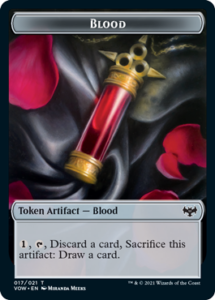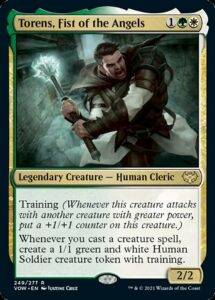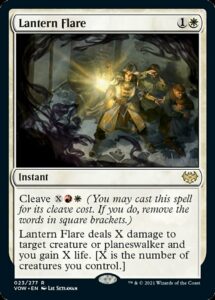2021 might be in the rear view mirror, but it introduced a variety of new mechanics, each worth reviewing and learning from. In past iterations, we’ve looked at Innistrad: Midnight Hunt and Adventures in the Forgotten Realms. Today, we’ll look at Midnight Hunt’s companion and the most recent set, Innistrad: Crimson Vow. It’s been out long enough that we’ve had ample opportunity to explore each of its mechanics.
Crimson Vow featured three returning mechanics in Exploit (we did a two part deep dive on why it underperformed), Disturb, and Daybound/Nightbound (both of which we covered in our Midnight Hunt mechanics article). Exploit and Daybound/Nightbound had little to no mechanical innovation, which is not at all a problem—if something isn’t broken, there’s no need to fix it. Plus, a set with six mechanics doesn’t need each mechanic to do heavy lifting.
Disturb, however, became a very different mechanic. While it remains a card advantage mechanic, flying creatures tend to be more valuable than auras, so WU Disturb decks in Crimson Vow played rather differently than those in Midnight Hunt. It’s a good a reminder that open-ended mechanics can be converted into impressively different play experiences by tweaking one foundational knob.
With that set, let’s zero in on Crimson Vow’s three new mechanics: Training, Blood tokens, and Cleave. We’ll start with Blood tokens, the mechanic associated with the set’s feature tribe, vampires.
Another artifact token joins the Cycle
2016’s Shadows over Innistrad introduced the world to Clue tokens, and Magic has never been the same again. There is a wealth of utility to generating artifacts that sacrifice themselves for free. It allows designers to add set-specific bonuses across a host of cards. It provides ample opportunities for synergy, be it with artifacts, tokens, sacrificing, the bonus the token generates, and entire economies using the token. We know that that this sort of mechanic is successful because we’ve seen it employed almost annually ever since. Clues in 2016. Treasure in 2017 and 2018. Food in 2019. Clues, Treasure, and Blood in 2021. So, our bar is set pretty high for Blood to begin with.
Mechanically, I love Blood. Its effect grants Cycling, which is one of Magic’s most powerful smoothing mechanics. Yes, it’s more fun for more players for a smoothing mechanic to involve playing all of your cards rather than tactically throwing them away (one of the reasons why Scry is evergreen and Cycling is not), but Blood gently addresses that issue. Because it’s a two step process, where you need to cast a spell (which critically requires some amount of mana) to then be able to Cycle a card using that Blood, there’s a bit of a delay built in. Having to wait a couple turns before you both have Blood and the ability to sacrifice said Blood makes it so you’re a little more likely to be Cycling lands away than spells. The fact that it’s a two step process makes it so Blood Cycling for a single, generic mana is fair when that was fairly game-breaking in Ikoria: Lair of Behemoths Limited.
I appreciate how Blood is distinct from all other types of artifact token. Clues and Treasures provide so much value by simply using them, that it’s hard to make them into alternate resources. Food is both expensive to sacrifice and provides a sometimes-worthless resource, so the mechanic is mostly built around finding ways to use Food rather than consistently using Food for its own sake. I think Blood hits this perfect sweet spot where you’re happy to use it (especially since it’s the only artifact token that requires one mana to use) and happy to spend it in other ways. This is why there’s a mixture of cards like Gluttonous Guest (which trigger off using Blood) and Bloodcrazed Socialite (which use Blood themselves).
My only nitpick about the mechanic is thematic. Blood tokens don’t feel like blood to me. Yes, blood could be used as a magical component for augury, but there’s not the visceral image of say, eating Food to become healthier, or following a Clue to gain knowledge. You have to think about it, first. That’s by no means a damning mark on Blood’s report card—Cycling is a completely flavorless mechanic—but it makes Blood a little bit harder to slide into a random set. I know that Mark Rosewater is aware of this critique and having heard about the design process for Blood, I understand that it being a mechanic that plays really well beats other considerations. And really, that’s all the bad I’ve got to say about the mechanic. Blood is awesome and makes me excited to see what the next token coming down the bend is.
Growing strong… every now and then
I had high hopes for Training when it was first revealed. It’s the inverse of Mentor, one of my favorite combat mechanics ever. It plays much more cleanly than Mentor, since you don’t need to pick targets or stack triggers carefully. It also presents a much simpler deckbuilding puzzle than Mentor, as you just need to play high power creatures rather than a bunch of small creatures. At first glance, I took notice of just how cheap Training seems to be costed—about 0.25 mana, making it almost free to add to creatures. Decayed zombies also cost about that much and they proved to be an incredibly powerful mechanic for it. Training did not.
Training underperformed in Crimson Vow Limited and no card with it made a big impact on Constructed. That doesn’t necessarily reflect poorly on its design—it could just mean that the Training was balanced on the weak side. But it could also mean the mechanic has inherent issues.
Training only works on small creatures. Sure, you can put it on a 4 power creature, but a +1/+1 counter has a minute effect on it compared to how it doubles a 1 power creature’s potency. (And being able to attack with a 4 mana creature already means you’re in great shape—having a 5 power creature to attack alongside is just overkill.) There’s simply only so much room for 1 and 2 power creatures in any given set. And putting Training on lots of cheap, 1 and 2 power creatures is risky. It’s a snowballing mechanic, where you can convert a small advantage into a larger and insurmountable advantages, and the only cost is playing creatures and attacking.
I think that’s why Training underperformed—the mechanic lends itself to a small band of creature sizes, it’s dangerous when it’s powerful, and it forces Play Design to think carefully about every 3+ power creature likely to be played in decks with Training. That’s not an execution problem, it’s a core balance issue baked into Training’s design.
I appreciate how Training cares about relative creature size, the same thing Coven did, but in a very different way. Though it doesn’t seem like it’ll work well alongside Coven in Innistrad: Double Feature, since creatures growing to match others creatures’ power is likely to disable Coven. Overall, Training seems like a cool, simpler take on Mentor, but it’s not dethroning Mentor in my book any time soon.
Brackets are cool, right?
Cleave is polarizing. It accomplishes a fairly brilliant twist on Kicker, where a spell transforms into a more powerful version of itself by removing a critical line of text. That’s a pretty narrow vein of design and I’m impressed Wizards created more Cleave cards in Crimson Vow than they did Training or Exploit cards. It’s also aesthetically awkward, and might require several read-throughs to understand and remember, especially if the reader hasn’t dabbled in programming. It’s a techy mechanic where you either appreciate the linguistic wizardy Wizards accomplished or roll your eyes at something too smart for its own good. And of course, there’s the name. Sure, Cleave technically means to cut or sever. But especially in the wake of a D&D set where Cleave is a Barbarian-associated ability about hitting multiple targets at once, using such a violent word to mean “edit text” feels silly.
Ultimately, I’m not a fan of Cleave. It feels like a mechanic that makes the designer feel smart more than the player has fun. The cards themselves are fine, but I wish more were like Lantern Flare (which is a split card) and fewer like Lunar Rejection (which is a main-deckable hate card with Kicker). But most importantly, I don’t know what it’s doing in Crimson Vow. Sets don’t need six mechanics (and yes, I think it was a mistake, albeit a small one, to include Investigate as a sixth mechanic in Midnight Hunt). Sure, this provides a spell-only mechanic in a set that needs five tribal mechanics that can all go on creatures, but it just feels unnecessary. Cleave was originally cut from Streets of New Capenna (a story we’ll likely hear more about this spring). I wish I understood better why it was crammed into Crimson Vow rather than saved for a future set that could have used it.
And that’s Crimson Vow. One mechanic I absolutely love, one I’m fairly tepid on, and one that’s not to my taste. That’s actually a pretty good report card, all things considered. I don’t often love mechanics and I love Blood tokens. Having an awesome mechanic elevates an expansion by itself. Sure, I don’t love Training and Cleave, but at 9 and 12 cards, they’re not marquee mechanics spread across the set; Blood is referenced on 31 cards. Not all mechanics are equally exciting or functional, so it’s a good idea to feature your best ones most prominently. That’s a good design lesson, and the kind only learnable from a game like Magic, one which needs to constantly generate new mechanics.
And, as always, thanks for reading.
Zachary Barash is a New York City-based game designer and the commissioner of Team Draft League. He designs for Kingdom Death: Monster, has a Game Design MFA from the NYU Game Center, and does freelance game design. When the stars align, he streams Magic (but the stars align way less often than he’d like).




